Malcolm R. Campbell's Blog, page 11
March 7, 2024
Good Plants: Black-Eyed Susan

Black-eyed Susan is a member of the Aster/Sunflower Family and is found throughout eastern and central North America. It is also called brown-eyed Susan, hairy coneflower, gloriosa daisy brown Betty, yellow ox-eye daisy coneflower, poor-land daisy, and golden Jerusalem. The prefers full sun and moist to moderately dry soil.” –The Lost Book Of Herbal Remedies
Both an annual (usually) and a perennial the plant is 3-foot tall by 1.5 foot wide with alternate, coarse-haired leaves, branching stems off a single tap root, reproduces by seeds, and displays flowers in the fall with a brown/black center and yellow petals. It is toxic to cats, and probably some farm animals (cattle, sheep, pigs). The seeds are poisonous.
Wikipedia classifies the plant as follows:
Kingdom:PlantaeClade:TracheophytesClade:AngiospermsClade:EudicotsClade:AsteridsOrder:AsteralesFamily:AsteraceaeGenus: Rudbeckia Species: R. hirtaIts primary use is in parks and home gardens.
It has medical uses–taken under a doctor’s consultation, including, (according to Practical Self Reliance) “snakebites, earaches, and get rid of parasitic worms. It has a long history of treating colds and the flu, but fewer people turn to this popular wildflower for anything other than filling a glass vase over the last century.”
Poison Control warns that “it should not be eaten. It can cause allergic skin reactions and asthma attacks in people sensitive to the plant.” Consult a doctor or herbalist before experimenting with slack-eyed susans. This information is provided for historical usage.
–Malcolm
March 2, 2024
PEN AMERICA CONDEMNS UC BERKELEY PROTESTS THAT TURNED VIOLENT, WITH REPORTED ANTISEMITIC BIGOTRY
Even with Deep Disagreements, No Student Should Have their Physical Safety at Risk, Nor Subjected to Taunts and Slurs
FOR IMMEDIATE RELEASE
February 29, 2024NEW YORK – PEN America today condemned protests at the University of California-Berkeley earlier this week that turned violent, included antisemitic slurs and gestures, and led to the cancellation of a planned lecture with Ran Bar-Yoshafat, deputy director of the Kohelet Policy Forum, an Israeli think tank.“The violent protests and reports of antisemitic bigotry that led to the event cancellation are abhorrent,” said Jonathan Friedman, director of free expression and education programs at PEN America. “No student should have their physical safety jeopardized for attending a public event on campus. While protest of any speaker is within students’ rights, violence, threats, and harassment are never appropriate. These protesters crossed the line — violating the rights of other students who organized the event and came to listen.”
 The lecture had been organized by multiple Jewish student organizations. Despite efforts by the University to safeguard the event, even moving it to a second location, it was ultimately canceled for safety reasons, in response to escalating violence. According to reports, about 200 protesters gathered outside the event venue on campus, before forcing their entry inside, smashing two windows and a door. Students who had come to attend the lecture have reported being physically assaulted, spit at, and injured, and that some protesters taunted them with antisemitic slurs. In response, the university has opened a formal criminal investigation and has initiated its student code-of-conduct process. An official statement from the University Chancellor and Provost said the attack on the event and the building constituted “an attack on the fundamental values of the university.”
The lecture had been organized by multiple Jewish student organizations. Despite efforts by the University to safeguard the event, even moving it to a second location, it was ultimately canceled for safety reasons, in response to escalating violence. According to reports, about 200 protesters gathered outside the event venue on campus, before forcing their entry inside, smashing two windows and a door. Students who had come to attend the lecture have reported being physically assaulted, spit at, and injured, and that some protesters taunted them with antisemitic slurs. In response, the university has opened a formal criminal investigation and has initiated its student code-of-conduct process. An official statement from the University Chancellor and Provost said the attack on the event and the building constituted “an attack on the fundamental values of the university.”
“University campuses must be a place for dialogue, even when there are deep disagreements,” Friedman continued. “This is a heckler’s veto taken to the extreme. We applaud Berkeley’s efforts to try to have the event go forward despite the planned disruption, to reach out to the affected students, and to investigate and enforce their policies in the aftermath. They should pursue appropriate accountability for those found responsible for the violence, threats, antisemitic slurs, and damaged property, as part of the investigation underway. While campuses must ensure that the fullest breadth of protected political speech can be heard, they must be able to take assertive steps so that events like this can be held safely.”
February 27, 2024
‘The Women’ by Kristin Hannah
 The Women was released this month by Kristin Hannah. That’s good news for those of us who love her work. According to Publishers Weekly, “Hannah’s emotionally charged page-turner (after The Four Winds) centers on a young nurse whose life is changed by the Vietnam War. Before Frankie McGrath begins basic training for the Army in 1966, her older brother Finley is killed in action. Frankie excels as a surgical nurse in Vietnam and becomes close with fellow nurses Ethel and Barb. After Ethel’s tour ends, Frankie and Barb gets assigned to the base at Pleiku, near the Cambodian border, where some of the heaviest fighting occurs. There, she reunites with Navy officer Rye Walsh, Finley’s best friend, and they become lovers. When Frankie returns to the U.S., she’s met with indifference for her service from her parents, who are still grieving her brother’s death, and disdain from people who oppose the war. She leans on alcohol and drugs while struggling to acclimate to civilian life. Though the situations and dialogue can feel contrived (Rye, after announcing he’s re-upping, says to Frankie at the close of a chapter, “I’m not leaving my girl”), Hannah’s depictions of Frankie tending to wounded soldiers are urgent and eye-opening, and a reunion of the three nurses for Frankie’s benefit is poignantly told. Fans of women’s historicals will enjoy this magnetic wartime story.”
The Women was released this month by Kristin Hannah. That’s good news for those of us who love her work. According to Publishers Weekly, “Hannah’s emotionally charged page-turner (after The Four Winds) centers on a young nurse whose life is changed by the Vietnam War. Before Frankie McGrath begins basic training for the Army in 1966, her older brother Finley is killed in action. Frankie excels as a surgical nurse in Vietnam and becomes close with fellow nurses Ethel and Barb. After Ethel’s tour ends, Frankie and Barb gets assigned to the base at Pleiku, near the Cambodian border, where some of the heaviest fighting occurs. There, she reunites with Navy officer Rye Walsh, Finley’s best friend, and they become lovers. When Frankie returns to the U.S., she’s met with indifference for her service from her parents, who are still grieving her brother’s death, and disdain from people who oppose the war. She leans on alcohol and drugs while struggling to acclimate to civilian life. Though the situations and dialogue can feel contrived (Rye, after announcing he’s re-upping, says to Frankie at the close of a chapter, “I’m not leaving my girl”), Hannah’s depictions of Frankie tending to wounded soldiers are urgent and eye-opening, and a reunion of the three nurses for Frankie’s benefit is poignantly told. Fans of women’s historicals will enjoy this magnetic wartime story.”
“Women can be heroes. When twenty-year-old nursing student Frances “Frankie” McGrath hears these words, it is a revelation. Raised in the sun-drenched, idyllic world of Southern California and sheltered by her conservative parents, she has always prided herself on doing the right thing. But in 1965, the world is changing, and she suddenly dares to imagine a different future for herself. When her brother ships out to serve in Vietnam, she joins the Army Nurse Corps and follows his path.
“As green and inexperienced as the men sent to Vietnam to fight, Frankie is over-whelmed by the chaos and destruction of war. Each day is a gamble of life and death, hope and betrayal; friendships run deep and can be shattered in an instant. In war, she meets―and becomes one of―the lucky, the brave, the broken, and the lost.
“But war is just the beginning for Frankie and her veteran friends. The real battle lies in coming home to a changed and divided America, to angry protesters, and to a country that wants to forget Vietnam.
“The Women is the story of one woman gone to war, but it shines a light on all women who put themselves in harm’s way and whose sacrifice and commitment to their country has too often been forgotten. A novel about deep friendships and bold patriotism, The Women is a richly drawn story with a memorable heroine whose idealism and courage under fire will come to define an era.”
From the Author’s Website “From master storyteller Kristin Hannah, #1 New York Times bestselling author of The Nightingale and The Four Winds, comes the story of a turbulent, transformative era in America: the 1960s. The Women is that rarest of novels―at once an intimate portrait of a woman coming of age in a dangerous time and an epic tale of a nation divided by war and broken by politics, of a generation both fueled by dreams and lost on the battlefield.”
“From master storyteller Kristin Hannah, #1 New York Times bestselling author of The Nightingale and The Four Winds, comes the story of a turbulent, transformative era in America: the 1960s. The Women is that rarest of novels―at once an intimate portrait of a woman coming of age in a dangerous time and an epic tale of a nation divided by war and broken by politics, of a generation both fueled by dreams and lost on the battlefield.”
“A former attorney, Kristin lives in the Pacific Northwest.”
–Malcolm
February 26, 2024
Putting that Hellhound into a Story
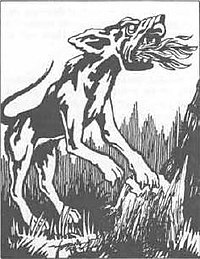 Yesterday’s post about hellhounds represents the kind of research a writer does when s/he plans to use a legendary monster, magical helper, or mythical place in a story. First, determine what is known about the place creature and how the beliefs about it change from place to place. In my case, I want to know what makes a hellhound a hellhound and whether or not it’s different in the American South.
Yesterday’s post about hellhounds represents the kind of research a writer does when s/he plans to use a legendary monster, magical helper, or mythical place in a story. First, determine what is known about the place creature and how the beliefs about it change from place to place. In my case, I want to know what makes a hellhound a hellhound and whether or not it’s different in the American South.
Basically, I think stories simply work better when they use attributes that generally fit the legends about the place, creature, or phenomenon because this matches the story to what people have heard and/or believe about the thing being described.
Naturally, authors are free to make up whatever they want, but the descriptions fall flat then they don’t link up to the readers’ general expectations about the critters or places. What I cannot forgive is the use of real places or real groups of people that don’t coincide with actual facts. For example, traditional witchcraft and Wicca are real, so the reality of these groups in a story needs to mesh with their beliefs and methods, not made-up stuff that doesn’t match the real world of these groups’ practices.
What’s real in the real world needs to stay real in the story. What’s mythical or folkloric in the real world needs to stay true to the parameters of the legends. Doing this makes for a better story and one that sounds true enough that readers think it could have happened.
–Malcolm
February 25, 2024
Of hellhounds
“I got to keep movin’, I got to keep movin’
Blues fallin’ down like hail, blues fallin’ down like hail
Hmm-mmm, blues fallin’ down like hail, blues fallin’ down like hail.” – From Robert Johnson’s blues song “Hellhound on My Trail”
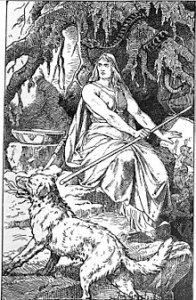 “A hellhound is a mythological hound that embodies a guardian or a servant of hell, the devil, or the underworld. Hellhounds occur in mythologies around the world, with the best-known examples being Cerberus from Greek mythology, Garmr from Norse mythology, the black dogs of English folklore, and the fairy hounds of Celtic mythology. Physical characteristics vary, but they are commonly black, anomalously overgrown, supernaturally strong, and often have red eyes or are accompanied by flames.” – Wikipedia
“A hellhound is a mythological hound that embodies a guardian or a servant of hell, the devil, or the underworld. Hellhounds occur in mythologies around the world, with the best-known examples being Cerberus from Greek mythology, Garmr from Norse mythology, the black dogs of English folklore, and the fairy hounds of Celtic mythology. Physical characteristics vary, but they are commonly black, anomalously overgrown, supernaturally strong, and often have red eyes or are accompanied by flames.” – Wikipedia
Shown here, “Goddess Hel and the Hellhound Garmr by Johannes Gehrts, 1889.” Garmr guards the gate of Hel in Norse Mythology.
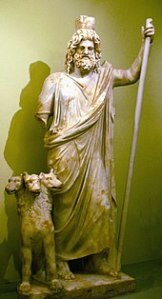 In Greek mythology, Cerberus guards the gates of hell and is called the hound of Hades. Typically, the hound is portrayed with three heads as is the dog guarding the depths of Hogwarts as shown in the Harry Potter film. The hound guards Hades’s gate to keep people from getting out.
In Greek mythology, Cerberus guards the gates of hell and is called the hound of Hades. Typically, the hound is portrayed with three heads as is the dog guarding the depths of Hogwarts as shown in the Harry Potter film. The hound guards Hades’s gate to keep people from getting out.
In the U.S., a hellhound is said to guard the hanging hills at Meriden, Connecticut, and was first mentioned by W. H. C. Pychon where he claimed that “If you meet the Black Dog once, it shall be for joy; if twice, it shall be for sorrow; and the third time shall bring death.” The trick here is keeping up with how often you’ve met one before.

 Wolves, and their supernatural cousins, the hellhounds, are a universal theme in myths, legends, and ghost stories. “The Omen,” a supernatural horror film released in 1976 to both mixed reviews and commercial success focuses on the nasty big dog. It’s fair to say that the hound of the Baskervilles fits neatly into the hellhound category.
Wolves, and their supernatural cousins, the hellhounds, are a universal theme in myths, legends, and ghost stories. “The Omen,” a supernatural horror film released in 1976 to both mixed reviews and commercial success focuses on the nasty big dog. It’s fair to say that the hound of the Baskervilles fits neatly into the hellhound category.
People ask which came first, the chicken or the egg? When it comes to hellhounds and other denizens, which came first, a natural fear of imagined things that go bump in the night or a fear of things that are “really out there” that we think may have come into your lives on a dark and stormy night?
I vote for the things really being out there.
–Malcolm
February 23, 2024
Feverfew in medicine and conjure
 “Tanacetum parthenium, known as feverfew, is a flowering plant in the daisy family, Asteraceae. It may be grown as an , and may be identified by its synonyms, Chrysanthemum parthenium and Pyrethrum parthenium.” – Wikipedia
“Tanacetum parthenium, known as feverfew, is a flowering plant in the daisy family, Asteraceae. It may be grown as an , and may be identified by its synonyms, Chrysanthemum parthenium and Pyrethrum parthenium.” – Wikipedia
In conjure, feverfew is used for love, protection against accident or illness, purification, uplifting the spirit, breaking biding spells, and for aspirin-oriented treatments. Do not ingest the plant without consulting a doctor. It can be purchased in powdered form for teas and in capsules.
Witch in the Woods says that “On an energetic plane, Feverfew is a balm for the spirit, calming and soothing the nervous system, particularly during times when the shadow self emerges. It aids in the alchemical transformation of nervous energy, preventing the manifestation of shadow habits and emotions. As a green ally in the herbalist’s enchanted garden, Feverfew offers its strength, adaptability, and confidence, illuminating the path during times of decision-making and shadow work. It opens the portals to higher realms of understanding, fostering trust in one’s intuitive gifts, and maintaining an anchored spirit amidst the dance of chaos and change.”
 In medicine, it’s been used to fight headaches, including migraines, as well as other inflamations. Studies are following research into feverfew and cancer and depression. In addition to the capsules, feverfew can be taken in tea and as a tincture. Drugs.com notes” An optimal dose of feverfew has not been established. For prevention of migraine, dried leaf preparation dosages ranging from 50 to 150 mg/day for various treatment durations have been evaluated in clinical trials.”
In medicine, it’s been used to fight headaches, including migraines, as well as other inflamations. Studies are following research into feverfew and cancer and depression. In addition to the capsules, feverfew can be taken in tea and as a tincture. Drugs.com notes” An optimal dose of feverfew has not been established. For prevention of migraine, dried leaf preparation dosages ranging from 50 to 150 mg/day for various treatment durations have been evaluated in clinical trials.”
Preparations in a variety of forms such as the one shown here are available online and at herbal shops.
–Malcolm
February 20, 2024
‘NCIS’ bids a sentimental farewell to the late David McCallum
 “NCIS” paid tribute to longtime cast member David McCallum with a special tribute episode, incorporating the death of his character, medical examiner Donald “Ducky” Mallard, into the show.
“NCIS” paid tribute to longtime cast member David McCallum with a special tribute episode, incorporating the death of his character, medical examiner Donald “Ducky” Mallard, into the show.
“Brian Dietzen, who plays Dr. Jimmy Palmer, co-wrote the episode, which featured Palmer showing up at Ducky’s house with coffee, only to discover him in bed, having died in his sleep.” – CNN
Deadline noted that “NCIS on Monday paid its final respects to star David McCallum, who died September 25 at the age of 90:
“A fan favorite, McCallum was the last remaining original cast member on NCIS, in which he played an eccentric but highly efficient investigator Donald “Ducky” Mallard for two decades.”
I think Dietzen did a great job with the storyline of the episode that aired last night on CBS. It had a nice mix of clips and a current focus that centered on a Marine who was purportedly called UA and murdered obverseas and dumped in a brothel with a lot of heroine in his system to further the career of a contactor. It took Ducky’s notes to help clear him.
 Like many NCIS viewers, I started watching McCallum in 1964’s “The Man from U.N.C.L.E,” so I’ve been seeing this actor on TV since I was in college. Robert Vaughn starred as Napolean Solo and McCallum played Illya Kuryakin.
Like many NCIS viewers, I started watching McCallum in 1964’s “The Man from U.N.C.L.E,” so I’ve been seeing this actor on TV since I was in college. Robert Vaughn starred as Napolean Solo and McCallum played Illya Kuryakin.
Thought it was delayed until last night due to the writers’ strike, the NCIS episode was well done and probably left most viewers with the feeling that the actor and NCIS cast member had suitable honored and remembered.
-Malcolm
February 19, 2024
‘The Dancing Wu Li Masters’ by Gary Zukav
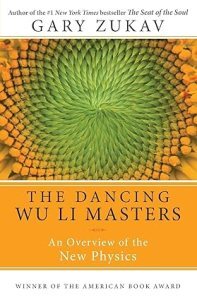 “Gary Zukav has written “the Bible” for those who are curious about the mind-expanding discoveries of advanced physics, but who have no scientific background. Like a Wu Li Master who would teach us wonder for the falling petal before speaking of gravity, Zukav writes in beautifully clear language—with no mathematical equations—opening our minds to the exciting new theories that are beginning to embrace the ultimate nature of our universe…Quantum mechanics, relativity, and beyond to the Einstein-Podolsky-Rosen effect and Bell’s theorem.” Mary Ellen Curtin at GoodReads
“Gary Zukav has written “the Bible” for those who are curious about the mind-expanding discoveries of advanced physics, but who have no scientific background. Like a Wu Li Master who would teach us wonder for the falling petal before speaking of gravity, Zukav writes in beautifully clear language—with no mathematical equations—opening our minds to the exciting new theories that are beginning to embrace the ultimate nature of our universe…Quantum mechanics, relativity, and beyond to the Einstein-Podolsky-Rosen effect and Bell’s theorem.” Mary Ellen Curtin at GoodReads
“The most exciting intellectual adventure I’ve been on since reading Robert Pirsig’s Zen and the Art of Motorcycle Maintenance.” – Christopher Lehmann-Haupt, New York Times
I read this book in 1979 when it was released. An exciting, thought-provoking book. I agreed with one reviewer who thought the constant l links to Zen were a bit much.
From the Publisher“Gary Zukav’s timeless, humorous, New York Times bestselling masterpiece, The Dancing Wu Li Masters, is arguably the most widely acclaimed introduction to quantum physics ever written. Scientific American raves: “Zukav is such a skilled expositor, with such an amiable style, that it is hard to imagine a layman who would not find his book enjoyable and informative.” Accessible, edifying, and endlessly entertaining, The Dancing Wu Li Masters is back in a beautiful new edition—and the doors to the fascinating, dazzling, remarkable world of quantum physics are opened to all once again, no previous mathematical or technical expertise required.”
About the Author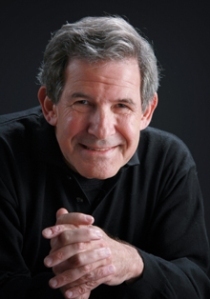 “Gary Zukav (born October 17, 1942) is an American spiritual teacher and the author of four consecutive New York Times Best Sellers. Beginning in 1998, he appeared more than 30 times on The Oprah Winfrey Show to discuss transformation in human consciousness concepts presented in his book The Seat of the Soul. His first book, The Dancing Wu Li Masters (1979), won a U.S. National Book Award.” Wikipedia
“Gary Zukav (born October 17, 1942) is an American spiritual teacher and the author of four consecutive New York Times Best Sellers. Beginning in 1998, he appeared more than 30 times on The Oprah Winfrey Show to discuss transformation in human consciousness concepts presented in his book The Seat of the Soul. His first book, The Dancing Wu Li Masters (1979), won a U.S. National Book Award.” Wikipedia
February 17, 2024
Banjo Patterson’s ‘The Man From Snowy River’
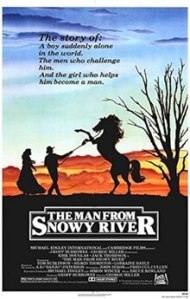 The Man from Snowy River”. The film had a cast including Kirk Douglas in a dual role as the brothers Harrison (a character who appeared frequently in Paterson’s poems) and Spur, Jack Thompson as Clancy, Tom Burlinson as Jim Craig, Sigrid Thornton as Harrison’s daughter Jessica, Terence Donovan as Jim’s father Henry Craig, and Chris Haywood as Curly. Both Burlinson and Thornton later reprised their roles in the 1988 sequel, The Man from Snowy River II (the film’s original Australian title). The 1988 sequel film was later released in the United States by Walt Disney Pictures under the title Return to Snowy River and in the United Kingdom under the title The Untamed.” – Wikipedia
The Man from Snowy River”. The film had a cast including Kirk Douglas in a dual role as the brothers Harrison (a character who appeared frequently in Paterson’s poems) and Spur, Jack Thompson as Clancy, Tom Burlinson as Jim Craig, Sigrid Thornton as Harrison’s daughter Jessica, Terence Donovan as Jim’s father Henry Craig, and Chris Haywood as Curly. Both Burlinson and Thornton later reprised their roles in the 1988 sequel, The Man from Snowy River II (the film’s original Australian title). The 1988 sequel film was later released in the United States by Walt Disney Pictures under the title Return to Snowy River and in the United Kingdom under the title The Untamed.” – Wikipedia
Like most viewers, I found this an enjoyable film even though Roger Ebert thought it was kind of corny even though he liked the scenes that show arial shots of herds of horses. Many critics point out that while Patterson provided a great ending, the ride to that ending the was bumpy. The film did well at the box office.
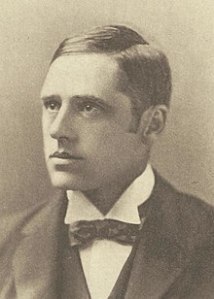 One thing I liked about the film was its popularization of the work of “Waltzing Matila” poet Banjo Patterson who was not a one-shot wonder with that poem. He lived from 1864 to 1941 and was known as an Australian bush poet, journalist and author.
One thing I liked about the film was its popularization of the work of “Waltzing Matila” poet Banjo Patterson who was not a one-shot wonder with that poem. He lived from 1864 to 1941 and was known as an Australian bush poet, journalist and author.
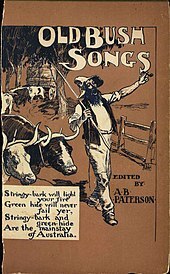 He began as an attorney and then started writing under the pseudonym of “The Banjo,” his favorite horse. Patterson’s image appears on the $10 note and on a 1981 postage stamp.
He began as an attorney and then started writing under the pseudonym of “The Banjo,” his favorite horse. Patterson’s image appears on the $10 note and on a 1981 postage stamp.
While he is best known for his songs and poems, he wrote two novels An Outback Marriage and The Shearer’s Colt and the “The Cast-Iron Canvasser” collection of short stories.
According to Wallis and Matilda, Patyerson “travelled to South Africa in 1899 as special war correspondent for The Sydney Morning Herald during the Boer War, and to China in 1901 with the intention of covering the Boxer Rebellion but he arrived after the uprising was over. By 1902 Paterson had left the legal profession. The following year he was appointed Editor of the Evening News (Sydney), a position he held until 1908 when he resigned to take over a property in Wee Jasper.”
“Waltzing Matilda” will, I think, always be his enduring claim to fame as generations of readers try to sort of the word meanings in this ballad.
–Malcolm
February 14, 2024
Potpourri for Valentine’s Day
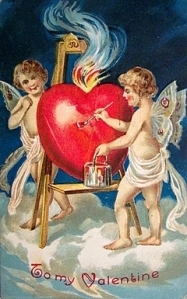 Valentine’s Day, also called Saint Valentine’s Day or the Feast of Saint Valentine, is celebrated annually on February 14. It originated as a Christian feast day honoring a martyr named Valentine, and through later folk traditions it has also become a significant cultural, religious and commercial celebration of romance and love in many regions of the world. – Wikipedia
Valentine’s Day, also called Saint Valentine’s Day or the Feast of Saint Valentine, is celebrated annually on February 14. It originated as a Christian feast day honoring a martyr named Valentine, and through later folk traditions it has also become a significant cultural, religious and commercial celebration of romance and love in many regions of the world. – Wikipedia“They have killed skinny jeans and continue to shame millennials for having side partings in their hair. They think using the crying tears emoji to express laughter is embarrassing. But now comes a surprising gen Z plot twist. One habit that those born between 1997 and 2012 are keen to endorse is reading – and it’s physical books rather than digital that they 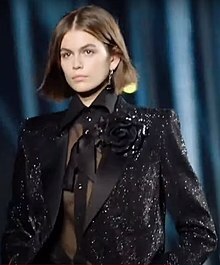 are thumbing. This week the 22-year-old model Kaia Gerber launched her own book club, Library Science. Gerber, who this month appears on the cover of British Vogue alongside her supermodel mum, Cindy Crawford, describes it as ‘a platform for sharing books, featuring new writers, hosting conversations with artists we admire – and continuing to build a community of people who are as excited about literature as I am’”. Guardian
are thumbing. This week the 22-year-old model Kaia Gerber launched her own book club, Library Science. Gerber, who this month appears on the cover of British Vogue alongside her supermodel mum, Cindy Crawford, describes it as ‘a platform for sharing books, featuring new writers, hosting conversations with artists we admire – and continuing to build a community of people who are as excited about literature as I am’”. Guardian

–Malcolm



